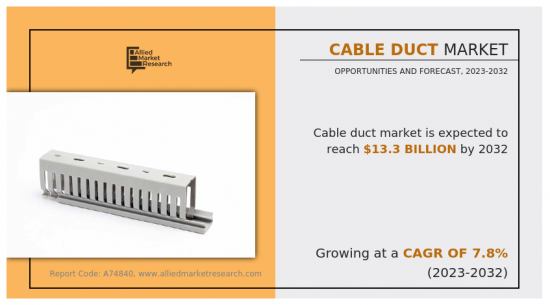
|
시장보고서
상품코드
1344364
케이블 덕트 시장 : 제품 유형별, 재료별, 최종 이용 산업별 - 세계 기회 분석 및 산업 예측(2023-2032년)Cable Duct Market By Product Type, By Material, By End Use Industry : Global Opportunity Analysis and Industry Forecast, 2023-2032 |
||||||
케이블 덕트 시장은 2022년 62억 달러로 평가되며 2023년부터 2032년까지 CAGR 7.8%로 성장하여 2032년에는 133억 달러에 달할 것으로 추정됩니다.

세계 케이블 덕트 시장의 성장은 전력 및 통신 인프라 수요 증가와 초고속 인터넷 수요 증가가 주요 요인으로 작용하고 있습니다. 또한, 각국 정부의 인프라 구축 노력도 시장 성장의 원동력이 될 것으로 보입니다. 그러나 높은 초기 설치 비용과 유지보수 비용이 세계 시장을 억제하는 주요 요인으로 작용하고 있습니다. 스마트 홈 및 스마트 빌딩에 대한 수요 증가는 예측 기간 동안 케이블 덕트 산업에 유리한 기회를 제공할 것으로 예상됩니다.
목차
제1장 서론
제2장 주요 요약
제3장 시장 개요
- 시장 정의와 범위
- 주요 조사 결과
- 영향요인
- 주요 투자 기회
- Porter's Five Forces 분석
- 공급 기업의 교섭력
- 구매자의 교섭력
- 대체품의 위협
- 신규 참여업체의 위협
- 경쟁의 강도
- 시장 역학
- 성장 촉진요인
- 전력·통신 인프라 수요 증가
- 고속 인터넷 수요 증가
- 정부에 의한 인프라 개발 이니셔티브
- 성장 억제요인
- 높은 설치 비용과 유지보수 비용
- 기회
- 스마트홈과 스마트 빌딩에 대한 수요 상승
- 성장 촉진요인
- COVID-19의 시장에 대한 영향 분석
제4장 케이블 덕트 시장 : 제품 유형별
- 개요
- 연질 케이블 덕트
- 경질 케이블 덕트
제5장 케이블 덕트 시장 : 재료별
- 개요
- PVC 케이블 덕트
- 폴리에틸렌 케이블 덕트
- 유리섬유 케이블 덕트
- 기타
제6장 케이블 덕트 시장 : 최종 이용 산업별
- 개요
- IT·통신
- 에너지·유틸리티
- 자동차
- 산업용 제조업
- 기타
제7장 케이블 덕트 시장 : 지역별
- 개요
- 북미
- 미국
- 캐나다
- 멕시코
- 유럽
- 독일
- 영국
- 프랑스
- 이탈리아
- 기타 유럽
- 아시아태평양
- 중국
- 일본
- 인도
- 한국
- 기타 아시아태평양
- 라틴아메리카
- 라틴아메리카
- 중동
- 아프리카
제8장 경쟁 상황
- 서론
- 주요 성공 전략
- 주요 10개사 제품 매핑
- 경쟁 대시보드
- 경쟁 히트맵
- 주요 기업의 포지셔닝, 2022년
제9장 기업 개요
- Legrand SA
- Schneider Electric SE.
- Atkore International Group Inc.
- ABB
- Panduit Corporation
- HellermannTyton Group PLC
- CommScope Holding Company, Inc.
- TE Connectivity Ltd.
- Leviton Manufacturing Co. Inc.
- Eaton Corporation
According to a new report published by Allied Market Research, titled, "Cable Duct Market," The cable duct market was valued at $6.2 billion in 2022, and is estimated to reach $13.3 billion by 2032, growing at a CAGR of 7.8% from 2023 to 2032.

The growth of global cable duct is majorly driven by the rise in demand for high-speed internet paired with an increase in demand for power and communication infrastructure. Moreover, the infrastructure development initiatives by governments are expected to drive market growth. However, the high initial installation and maintenance costs act as prime restraints of the global market. Growth in demand for smart homes and buildings is anticipated to provide lucrative opportunities for the cable duct industry during the forecast period.
The cable duct market is segmented into product type, material, end-use industry, and region. On the basis of product type, the market is bifurcated into flexible cable duct and rigid cable duct. On the basis of material, the market is fragmented into PVC cable duct, polyethylene cable ducts, fiberglass cable ducts, and others. On the basis of end-use industry, the cable duct market is classified into IT and telecommunications, energy and utility, automotive, industrial manufacturing, and others.
On the basis of region, the cable duct market trends are analyzed across North America (the U.S., Canada, and Mexico), Europe (the UK, Germany, France, Italy, and Rest of Europe), Asia-Pacific (China, Japan, India, South Korea, and Rest of Asia-Pacific), and LAMEA (Latin America, Middle East, and Africa). The key players operating in the market include Legrand SA, Schneider Electric SE, Atkore International Group Inc., ABB Ltd., Panduit Corporation, HellermannTyton Group PLC, CommScope Holding Company, Inc., TE Connectivity Ltd., Leviton Manufacturing Co. Inc., and Eaton Corporation.
Key Benefits For Stakeholders
- This report provides a quantitative analysis of the market segments, current trends, estimations, and dynamics of the cable duct market analysis from 2022 to 2032 to identify the prevailing cable duct market opportunities.
- The market research is offered along with information related to key drivers, restraints, and opportunities.
- Porter's five forces analysis highlights the potency of buyers and suppliers to enable stakeholders make profit-oriented business decisions and strengthen their supplier-buyer network.
- In-depth analysis of the cable duct market segmentation assists to determine the prevailing market opportunities.
- Major countries in each region are mapped according to their revenue contribution to the global market.
- Market player positioning facilitates benchmarking and provides a clear understanding of the present position of the market players.
- The report includes the analysis of the regional as well as global cable duct market trends, key players, market segments, application areas, and market growth strategies.
Key Market Segments
By Product Type
- Rigid cable duct
- Flexible cable duct
By Material
- PVC cable duct
- Polyethylene cable duct
- Others
- Fiberglass cable duct
By End Use Industry
- IT and Telecommunication
- Energy and Utility
- Automotive
- Industrial Manufacturing
- Others
By Region
- North America
- U.S.
- Canada
- Mexico
- Europe
- Germany
- UK
- France
- Italy
- Rest of Europe
- Asia-Pacific
- China
- Japan
- India
- South Korea
- Rest of Asia-Pacific
- LAMEA
- Latin America
- Middle East
- Africa
Key Market Players:
- ABB
- Eaton Corporation
- Panduit Corporation
- Legrand SA
- HellermannTyton Group PLC
- TE Connectivity Ltd.
- Atkore International Group Inc.
- CommScope Holding Company, Inc.
- Leviton Manufacturing Co. Inc.
- Schneider Electric SE.
TABLE OF CONTENTS
CHAPTER 1: INTRODUCTION
- 1.1. Report description
- 1.2. Key market segments
- 1.3. Key benefits to the stakeholders
- 1.4. Research Methodology
- 1.4.1. Primary research
- 1.4.2. Secondary research
- 1.4.3. Analyst tools and models
CHAPTER 2: EXECUTIVE SUMMARY
- 2.1. CXO Perspective
CHAPTER 3: MARKET OVERVIEW
- 3.1. Market definition and scope
- 3.2. Key findings
- 3.2.1. Top impacting factors
- 3.2.2. Top investment pockets
- 3.3. Porter's five forces analysis
- 3.3.1. Bargaining power of suppliers
- 3.3.2. Bargaining power of buyers
- 3.3.3. Threat of substitutes
- 3.3.4. Threat of new entrants
- 3.3.5. Intensity of rivalry
- 3.4. Market dynamics
- 3.4.1. Drivers
- 3.4.1.1. Increasing demand for power and communication infrastructure
- 3.4.1.2. Rising demand for high-speed internet
- 3.4.1.3. Infrastructure development initiatives by governments
- 3.4.1. Drivers
- 3.4.2. Restraints
- 3.4.2.1. High installation and maintenance costs
- 3.4.3. Opportunities
- 3.4.3.1. Growing demand for smart homes and buildings
- 3.5. COVID-19 Impact Analysis on the market
CHAPTER 4: CABLE DUCT MARKET, BY PRODUCT TYPE
- 4.1. Overview
- 4.1.1. Market size and forecast
- 4.2. Flexible cable duct
- 4.2.1. Key market trends, growth factors and opportunities
- 4.2.2. Market size and forecast, by region
- 4.2.3. Market share analysis by country
- 4.3. Rigid cable duct
- 4.3.1. Key market trends, growth factors and opportunities
- 4.3.2. Market size and forecast, by region
- 4.3.3. Market share analysis by country
CHAPTER 5: CABLE DUCT MARKET, BY MATERIAL
- 5.1. Overview
- 5.1.1. Market size and forecast
- 5.2. PVC cable duct
- 5.2.1. Key market trends, growth factors and opportunities
- 5.2.2. Market size and forecast, by region
- 5.2.3. Market share analysis by country
- 5.3. Polyethylene cable duct
- 5.3.1. Key market trends, growth factors and opportunities
- 5.3.2. Market size and forecast, by region
- 5.3.3. Market share analysis by country
- 5.4. Fiberglass cable duct
- 5.4.1. Key market trends, growth factors and opportunities
- 5.4.2. Market size and forecast, by region
- 5.4.3. Market share analysis by country
- 5.5. Others
- 5.5.1. Key market trends, growth factors and opportunities
- 5.5.2. Market size and forecast, by region
- 5.5.3. Market share analysis by country
CHAPTER 6: CABLE DUCT MARKET, BY END USE INDUSTRY
- 6.1. Overview
- 6.1.1. Market size and forecast
- 6.2. IT and Telecommunication
- 6.2.1. Key market trends, growth factors and opportunities
- 6.2.2. Market size and forecast, by region
- 6.2.3. Market share analysis by country
- 6.3. Energy and Utility
- 6.3.1. Key market trends, growth factors and opportunities
- 6.3.2. Market size and forecast, by region
- 6.3.3. Market share analysis by country
- 6.4. Automotive
- 6.4.1. Key market trends, growth factors and opportunities
- 6.4.2. Market size and forecast, by region
- 6.4.3. Market share analysis by country
- 6.5. Industrial Manufacturing
- 6.5.1. Key market trends, growth factors and opportunities
- 6.5.2. Market size and forecast, by region
- 6.5.3. Market share analysis by country
- 6.6. Others
- 6.6.1. Key market trends, growth factors and opportunities
- 6.6.2. Market size and forecast, by region
- 6.6.3. Market share analysis by country
CHAPTER 7: CABLE DUCT MARKET, BY REGION
- 7.1. Overview
- 7.1.1. Market size and forecast By Region
- 7.2. North America
- 7.2.1. Key trends and opportunities
- 7.2.2. Market size and forecast, by Product Type
- 7.2.3. Market size and forecast, by Material
- 7.2.4. Market size and forecast, by End Use Industry
- 7.2.5. Market size and forecast, by country
- 7.2.5.1. U.S.
- 7.2.5.1.1. Key market trends, growth factors and opportunities
- 7.2.5.1.2. Market size and forecast, by Product Type
- 7.2.5.1.3. Market size and forecast, by Material
- 7.2.5.1.4. Market size and forecast, by End Use Industry
- 7.2.5.2. Canada
- 7.2.5.2.1. Key market trends, growth factors and opportunities
- 7.2.5.2.2. Market size and forecast, by Product Type
- 7.2.5.2.3. Market size and forecast, by Material
- 7.2.5.2.4. Market size and forecast, by End Use Industry
- 7.2.5.3. Mexico
- 7.2.5.3.1. Key market trends, growth factors and opportunities
- 7.2.5.3.2. Market size and forecast, by Product Type
- 7.2.5.3.3. Market size and forecast, by Material
- 7.2.5.3.4. Market size and forecast, by End Use Industry
- 7.3. Europe
- 7.3.1. Key trends and opportunities
- 7.3.2. Market size and forecast, by Product Type
- 7.3.3. Market size and forecast, by Material
- 7.3.4. Market size and forecast, by End Use Industry
- 7.3.5. Market size and forecast, by country
- 7.3.5.1. Germany
- 7.3.5.1.1. Key market trends, growth factors and opportunities
- 7.3.5.1.2. Market size and forecast, by Product Type
- 7.3.5.1.3. Market size and forecast, by Material
- 7.3.5.1.4. Market size and forecast, by End Use Industry
- 7.3.5.2. UK
- 7.3.5.2.1. Key market trends, growth factors and opportunities
- 7.3.5.2.2. Market size and forecast, by Product Type
- 7.3.5.2.3. Market size and forecast, by Material
- 7.3.5.2.4. Market size and forecast, by End Use Industry
- 7.3.5.3. France
- 7.3.5.3.1. Key market trends, growth factors and opportunities
- 7.3.5.3.2. Market size and forecast, by Product Type
- 7.3.5.3.3. Market size and forecast, by Material
- 7.3.5.3.4. Market size and forecast, by End Use Industry
- 7.3.5.4. Italy
- 7.3.5.4.1. Key market trends, growth factors and opportunities
- 7.3.5.4.2. Market size and forecast, by Product Type
- 7.3.5.4.3. Market size and forecast, by Material
- 7.3.5.4.4. Market size and forecast, by End Use Industry
- 7.3.5.5. Rest of Europe
- 7.3.5.5.1. Key market trends, growth factors and opportunities
- 7.3.5.5.2. Market size and forecast, by Product Type
- 7.3.5.5.3. Market size and forecast, by Material
- 7.3.5.5.4. Market size and forecast, by End Use Industry
- 7.4. Asia-Pacific
- 7.4.1. Key trends and opportunities
- 7.4.2. Market size and forecast, by Product Type
- 7.4.3. Market size and forecast, by Material
- 7.4.4. Market size and forecast, by End Use Industry
- 7.4.5. Market size and forecast, by country
- 7.4.5.1. China
- 7.4.5.1.1. Key market trends, growth factors and opportunities
- 7.4.5.1.2. Market size and forecast, by Product Type
- 7.4.5.1.3. Market size and forecast, by Material
- 7.4.5.1.4. Market size and forecast, by End Use Industry
- 7.4.5.2. Japan
- 7.4.5.2.1. Key market trends, growth factors and opportunities
- 7.4.5.2.2. Market size and forecast, by Product Type
- 7.4.5.2.3. Market size and forecast, by Material
- 7.4.5.2.4. Market size and forecast, by End Use Industry
- 7.4.5.3. India
- 7.4.5.3.1. Key market trends, growth factors and opportunities
- 7.4.5.3.2. Market size and forecast, by Product Type
- 7.4.5.3.3. Market size and forecast, by Material
- 7.4.5.3.4. Market size and forecast, by End Use Industry
- 7.4.5.4. South Korea
- 7.4.5.4.1. Key market trends, growth factors and opportunities
- 7.4.5.4.2. Market size and forecast, by Product Type
- 7.4.5.4.3. Market size and forecast, by Material
- 7.4.5.4.4. Market size and forecast, by End Use Industry
- 7.4.5.5. Rest of Asia-Pacific
- 7.4.5.5.1. Key market trends, growth factors and opportunities
- 7.4.5.5.2. Market size and forecast, by Product Type
- 7.4.5.5.3. Market size and forecast, by Material
- 7.4.5.5.4. Market size and forecast, by End Use Industry
- 7.5. LAMEA
- 7.5.1. Key trends and opportunities
- 7.5.2. Market size and forecast, by Product Type
- 7.5.3. Market size and forecast, by Material
- 7.5.4. Market size and forecast, by End Use Industry
- 7.5.5. Market size and forecast, by country
- 7.5.5.1. Latin America
- 7.5.5.1.1. Key market trends, growth factors and opportunities
- 7.5.5.1.2. Market size and forecast, by Product Type
- 7.5.5.1.3. Market size and forecast, by Material
- 7.5.5.1.4. Market size and forecast, by End Use Industry
- 7.5.5.2. Middle East
- 7.5.5.2.1. Key market trends, growth factors and opportunities
- 7.5.5.2.2. Market size and forecast, by Product Type
- 7.5.5.2.3. Market size and forecast, by Material
- 7.5.5.2.4. Market size and forecast, by End Use Industry
- 7.5.5.3. Africa
- 7.5.5.3.1. Key market trends, growth factors and opportunities
- 7.5.5.3.2. Market size and forecast, by Product Type
- 7.5.5.3.3. Market size and forecast, by Material
- 7.5.5.3.4. Market size and forecast, by End Use Industry
CHAPTER 8: COMPETITIVE LANDSCAPE
- 8.1. Introduction
- 8.2. Top winning strategies
- 8.3. Product Mapping of Top 10 Player
- 8.4. Competitive Dashboard
- 8.5. Competitive Heatmap
- 8.6. Top player positioning, 2022
CHAPTER 9: COMPANY PROFILES
- 9.1. Legrand SA
- 9.1.1. Company overview
- 9.1.2. Key Executives
- 9.1.3. Company snapshot
- 9.1.4. Operating business segments
- 9.1.5. Product portfolio
- 9.1.6. Business performance
- 9.2. Schneider Electric SE.
- 9.2.1. Company overview
- 9.2.2. Key Executives
- 9.2.3. Company snapshot
- 9.2.4. Operating business segments
- 9.2.5. Product portfolio
- 9.2.6. Business performance
- 9.3. Atkore International Group Inc.
- 9.3.1. Company overview
- 9.3.2. Key Executives
- 9.3.3. Company snapshot
- 9.3.4. Operating business segments
- 9.3.5. Product portfolio
- 9.3.6. Business performance
- 9.3.7. Key strategic moves and developments
- 9.4. ABB
- 9.4.1. Company overview
- 9.4.2. Key Executives
- 9.4.3. Company snapshot
- 9.4.4. Operating business segments
- 9.4.5. Product portfolio
- 9.4.6. Business performance
- 9.4.7. Key strategic moves and developments
- 9.5. Panduit Corporation
- 9.5.1. Company overview
- 9.5.2. Key Executives
- 9.5.3. Company snapshot
- 9.5.4. Operating business segments
- 9.5.5. Product portfolio
- 9.5.6. Key strategic moves and developments
- 9.6. HellermannTyton Group PLC
- 9.6.1. Company overview
- 9.6.2. Key Executives
- 9.6.3. Company snapshot
- 9.6.4. Operating business segments
- 9.6.5. Product portfolio
- 9.7. CommScope Holding Company, Inc.
- 9.7.1. Company overview
- 9.7.2. Key Executives
- 9.7.3. Company snapshot
- 9.7.4. Operating business segments
- 9.7.5. Product portfolio
- 9.7.6. Business performance
- 9.8. TE Connectivity Ltd.
- 9.8.1. Company overview
- 9.8.2. Key Executives
- 9.8.3. Company snapshot
- 9.8.4. Operating business segments
- 9.8.5. Product portfolio
- 9.8.6. Business performance
- 9.9. Leviton Manufacturing Co. Inc.
- 9.9.1. Company overview
- 9.9.2. Key Executives
- 9.9.3. Company snapshot
- 9.9.4. Operating business segments
- 9.9.5. Product portfolio
- 9.9.6. Key strategic moves and developments
- 9.10. Eaton Corporation
- 9.10.1. Company overview
- 9.10.2. Key Executives
- 9.10.3. Company snapshot
- 9.10.4. Operating business segments
- 9.10.5. Product portfolio
- 9.10.6. Business performance



















